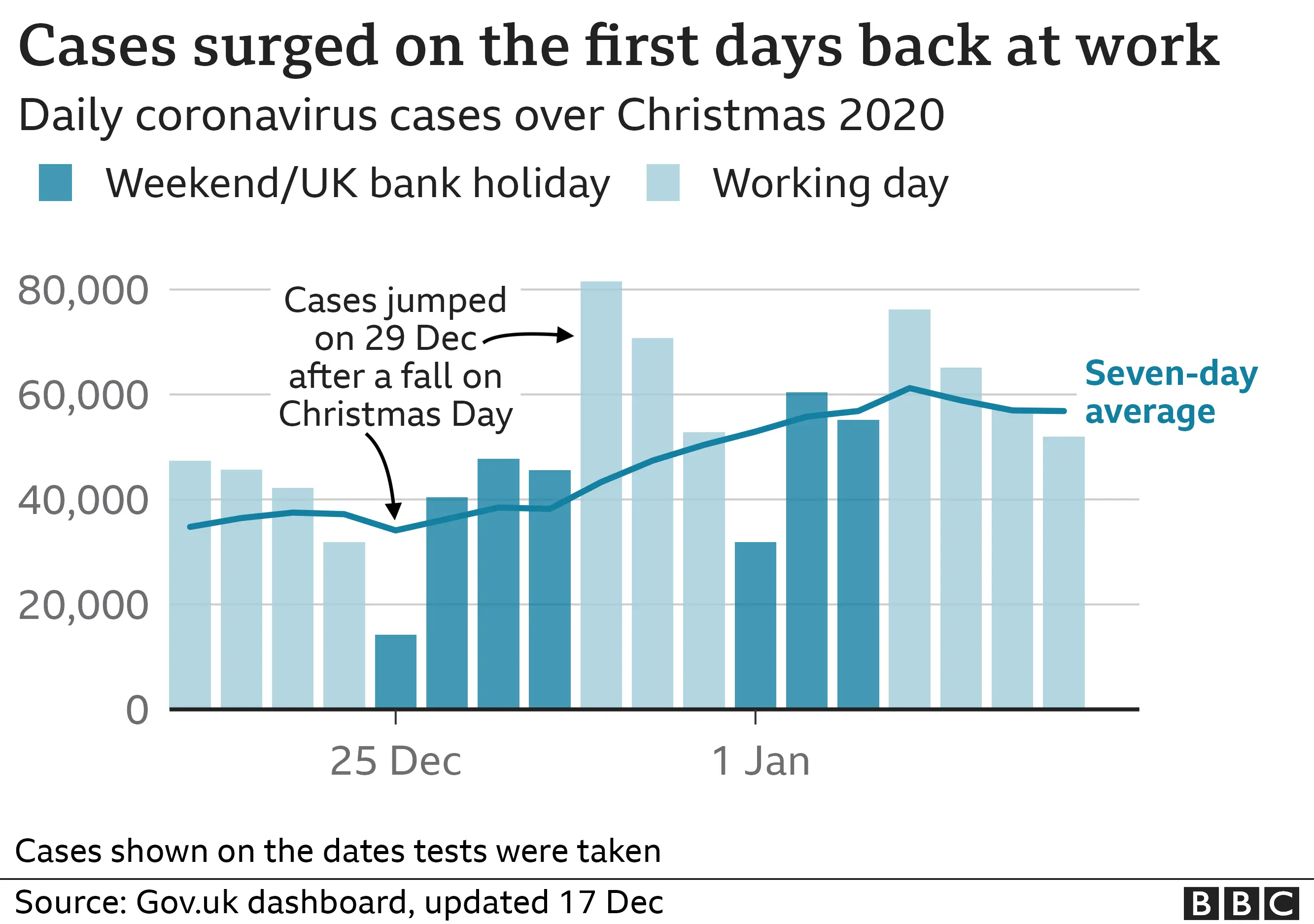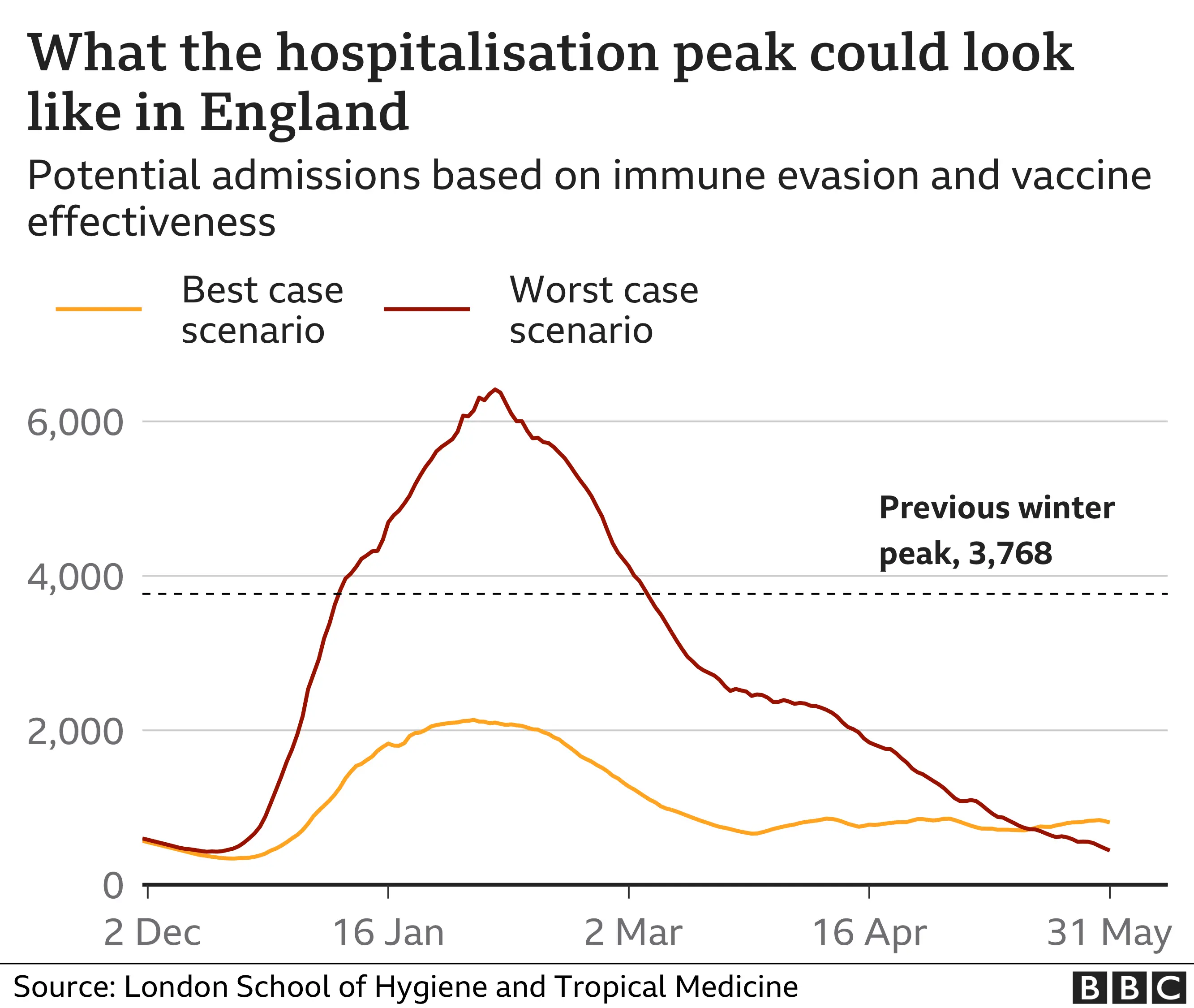Coronavirus: Is Christmas the time to lay off the daily diet of stats?
 Getty Images
Getty ImagesChristmas lifestyle advice normally focuses on watching your mince pie intake, but this year should we restrict our daily diet of Covid stats too?
We know a big wave of Omicron infections is coming. But the daily case numbers won't tell us whether it's speeding up or slowing down.
And daily hospital admissions data won't give us a clear picture of how serious the new variant is for some time.
So here are three reasons to cut down on stats during the holidays, two numbers you can "cheat" with - and one tip to help if you really do want to do cold turkey.
Daily cases dependent on tests taken
It may be tempting to read every peak and trough in the daily cases as evidence about the speed of Omicron's spread.
But often it just tells us who came forward for testing.
Christmas Day and New Year's Day last year saw sharp falls in people testing positive. And the two biggest days for cases in the UK before the Omicron wave were the days after the Christmas and New Year bank holidays when we returned to work.

Rapid tests are being used much more this Christmas. They can help to slow the spread of the virus, and catch people who might otherwise pass it on.
But they muddy the data because it is not clear whether they are spotting more asymptomatic infections as people check more frequently, or instead missing people who decide not to report their test.
Daily cases dependent on capacity
There are concerns Omicron will grow too fast for the testing system to cope.
The UK is currently using nearly three quarters of the available lab Covid tests each day, with increases in demand expected.
If the system struggles and test results take longer to come back, that would make it look like Omicron is slowing down.
Normally admissions give us useful, but delayed, insight into the trends in infections. Someone who catches coronavirus today might not be admitted to hospital before 2022.
But, when things are moving so fast with Omicron, the daily admissions figures won't provide the answer we need soon enough.
Daily admissions don't tell us enough about Omicron's severity
The daily headline number of people going into hospital with coronavirus tells us about the direction of travel.
London, furthest into the Omicron wave, has already started to see admissions rise sharply.
We won't know how bad things might get until we know how sick Omicron makes you, and how well the vaccines protect you from sickness.
At the moment, projections for the Omicron peak in admissions can range between half as bad and twice as bad as last January's. That's a very wide range.

The daily figures won't narrow that for some time because they don't tell us whether someone is going into hospital with Omicron or Delta or whether they were vaccinated.
And SAGE warn that the current numbers of Omicron infections admitted to hospital are "probably around one tenth of the true number" because of delays in reporting.
For these reasons, many devotees of the daily data will be taking a break.
Prof Oliver Johnson, a mathematician whose daily Covid charts have earned him tens of thousands of followers on Twitter, worries that the daily trends may not be "completely reliable". He plans to step back from his charts until the new year.
What Covid numbers can I trust over Christmas?
But data will keep arriving, some of it bringing a "better understanding" of Omicron, according to Prof Azra Ghani, one of the modellers whose work informs government. She only anticipates having a "couple of days" off over Christmas.
If you do need a hit of stats over the holidays look for the less frequent, but more helpful, studies.
Infection surveys help us keep an eye on Omicron's spread even when the daily data are stretched or unhelpful.
They swab people at random and so aren't messed around by people deciding to get tested or to wait for a few days. Look out for the REACT or Office for National Statistics (ONS) surveys.
And, once there are enough data from hospitals, UKSHA is planning a study looking at how sick Omicron makes people and how well vaccines protect you.
Look out for that too. They have already shown that boosters increase your protection from catching a case of Omicron.
 Getty Images
Getty ImagesHow do I stop 'doomscrolling' Covid data?
But it may be hard for many of us to break the daily figures fix.
The desire to continually monitor outbreaks is an "emotional response" explains psychologist Dr Pamela Rutledge: our brains pushing us to understand an uncertain environment in order to stay safe.
And interest in the UK government's Covid dashboard has been hitting record levels during the Omicron wave.
Prof Rutledge likens controlling those emotional impulses to a rider trying to control an elephant and suggests using "mindful intention" to keep the rider in control.
Tricks like setting time limits for your searching can help to interrupt behaviours you return to unconsciously.
She also recommends consciously monitoring your emotions and doing things that make you happy, saying "positive emotions are the best antidote for anxiety".
